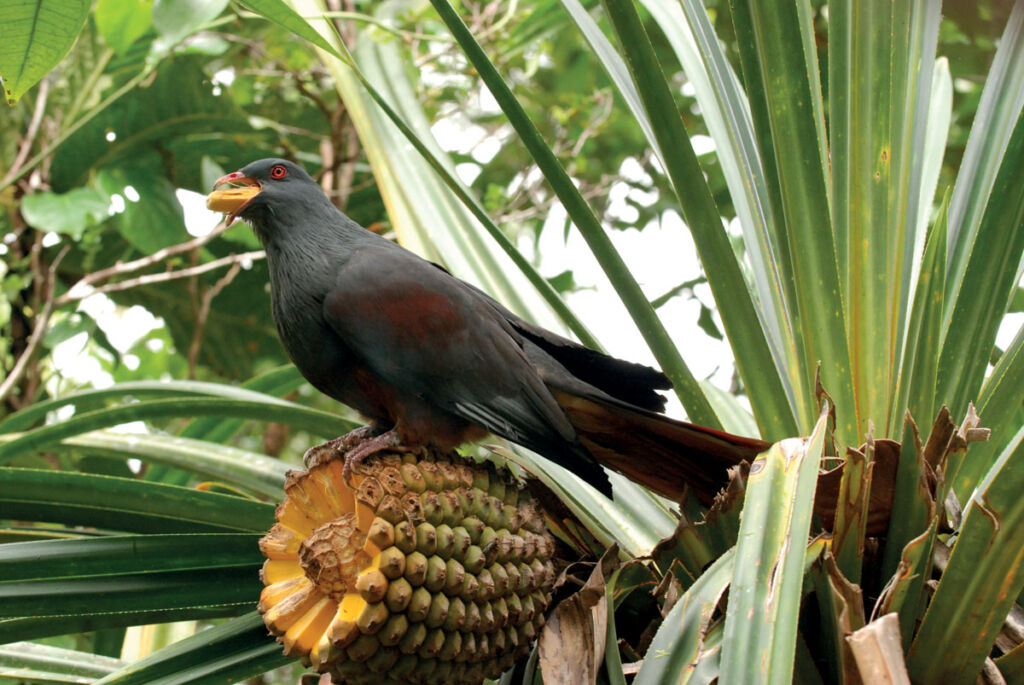[LUM#14] Dear rare species
How do we determine whether a species is rare? A new study alerts us to the need to consider the functional rarity of species in order to take account of their ecological role. An invitation to reorient conservation biology towards an ecosystem approach. Here's how it works.

It measures over 50 centimetres and can weigh up to a kilo, making it the largest tree-dwelling pigeon in the world and earning it its nickname: the giant carpophagus, Ducula goliath to its friends. This unusual pigeon hides its red eyes and slate and tawny plumage in the primary rainforest of New Caledonia, where everyone knows it by its common name, the notou. And the notou has a unique characteristic: it has a beak with a lower mandible capable of deforming, enabling it to gobble up fruits over 5 centimetres in diameter.
His favourite menu? The fruits of the pandanus, a small tree endemic to New Caledonia(see photo). As the only bird capable of ingesting them, it contributes effectively to the dispersal of pandanus seeds, as well as those of several other trees with very large fruits. But the notou is now under threat: hunted, a victim of habitat destruction and low reproduction - with only one egg laid each year - its population is declining. So what would happen to the pandanus and this entire tropical ecosystem if the giant carpophagus were to become extinct?
Functional rarity
This question opens up a new horizon for conservation biology, that of the functional rarity of species. The notou plays a unique ecological role in its environment, making it irreplaceable. " It is an ecologically rare species, because it is essential to the proper functioning of its ecosystem", explain Nicolas Loiseau* and Nicolas Mouquet, co-authors of a study on the ecological rarity of species, financed at Cesab by the Foundation for Research on Biodiversity and EDF.
Until now, a species has been considered rare when its population was limited to a small number of individuals or when it lived in a very restricted geographical area. Researchers are calling for these characteristics to be broadened: "the role played by these species in their ecosystem, and the way in which they contribute to its functioning, must also be taken into account", stresses Nicolas Mouquet, Scientific Director of the Centre de synthèse et d'analyse sur la biodiversité (Cesab).
Together with their colleagues from CNRS andGrenoble Alpes University, the scientists analyzed databases containing almost 15,000 land mammals and birds to map ecologically rare species worldwide. This painstaking work has enabled them to identify, alongside the notou, the New Zealand kakapo, the only flightless parrot in the world, which activates the decomposition of the soil it treads on for almost a century, giving it an extraordinary life expectancy. Or the black macaque on the Indonesian island of Sulawesi, which feeds on 145 varieties of fruit and scatters the seeds of as many tree species. And many other birds, rodents, lemurs, bats. ..". An ecological rarity that is concentrated in the tropics and the southern hemisphere, particularly on islands", note the ecologists.
Double punishment
How do they go about identifying these ecologically rare species? "We observe the functional traits of a species by deciphering its lifestyle: does it live at ground level or in the canopy? Is it diurnal or nocturnal? What is its diet? answers Nicolas Loiseau. We consider that the more a species possesses an original combination of traits, the more important it is for the ecosystem", adds the researcher. And if this species disappears? "Then this combination of functional traits will not be realized by another species, and the ecosystem is more likely to be disrupted than when a functionally redundant species disappears. Redundant? " That's how we describe a species when its functions can be fulfilled by others, as an "insurance policy" in the event of its disappearance," explains Nicolas Mouquet. To lose an ecologically rare species is therefore to lose the species itself, but also its function in the ecosystem: an irremediable loss, a veritable "double penalty" according to the researchers.
These are all swords of Damocles hanging over these ecosystems, in a context where ecologically rare species appear to be particularly threatened, notably by global warming and human activities. We have modelled the distribution of these species between now and 2050-2080 on the basis of the IPCC's climate change scenarios," explains Nicolas Loiseau, " and our results show that the negative impact will be greater for these species, with range losses of over 50% in the case of certain birds." More threatened... and less well protected. " Ecologically rare species are generally less well protected than others," lament the researchers.
Paradigm shift
This alarming finding is an incentive to take ecological scarcity and the idea of ecosystem functioning into account in conservation programs. While some of the animals identified in this study are already considered threatened with extinction by theInternational Union for Conservation of Nature (IUCN), this is not the case for all ecologically rare species. " This 'profiling' of ecologically rare species highlights the fact that their preservation, even in currently protected areas, is not sufficient," regrets Nicolas Mouquet. Species conservation is too often based on their identity and demographic status. Yet taking into account the originality of their ecological roles is essential and should also guide conservation actions." A call for a real paradigm shift in the conservation policies to be implemented. "We hope that these new data will lead to new decision-making tools. A better understanding will lead to better conservation.
Read also:
UM podcasts are now available on your favorite platforms (Spotify, Deezer, Apple podcasts, Amazon Music...).
*Marbec (UM - CNRS - IRD - Ifremer) Global distribution and conservation status of ecologically rare mammal and bird species. Nicolas Loiseau, Nicolas Mouquet, Nicolas Casajus, Matthias Grenié, Maya Gueguen, Brian Maitner, David Mouillot, Annette Ostling, Julien Renaud, Caroline Tucker, Laure Velez, Wilfried Thuiller, Cyrille Violle. Nature communications, October 8, 2020.